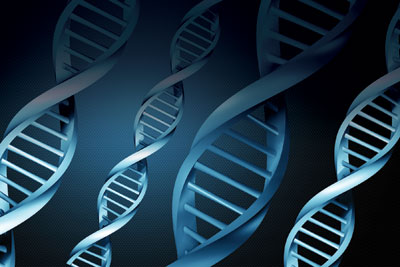Insights (page 3)
Getting the roots of disease

Our genes are busy little multi-taskers. Take the PTB1b gene. At normal levels, the PTB1b enzyme helps regulate cell growth and cell division. Too much PTB1b, however, causes cells to grow out of control. Now Michel Tremblay, director of the McGill Cancer Centre, has found that 40 per cent of breast cancer cases in women are a result of over expression of PTB1b.
A mere seven years ago, Tremblay linked this same gene to obesity and diabetes — and pharmaceutical companies are already doing human trials for PTB1b-suppressing drugs. This quick progress may mean that a breakthrough breast cancer drug is just on the horizon. “Adapting these compounds is all that is needed to attack breast cancer,” Tremblay explains. Of course, just as one gene can be linked to more than one disease, a disease like breast cancer involves a number of genes working in concert. Fortunately, researchers such as William Foulkes are furthering our understanding of these deadly tangles of DNA segments. Foulkes, the director of McGill’s cancer genetics program, recently characterized two mutations on the PALB2 gene that seem to relate to a particular breast cancer “signature.” Though it is unclear whether these mutations play a role in causing breast cancer, it appears that individuals with the mutations have a higher risk of developing the disease.
Foulkes describes the discovery — made with collaborators at Montreal’s Jewish General Hospital, Harvard’s Dana Farber Cancer Institute, the Institute of Cancer Research in London, England, and the Netherlands Cancer Institute — as another “factual brick” in our still-under-construction understanding of breast cancer.
“Approximately 10 genes, including PALB2, have now been associated with a two-fold or greater risk for breast cancer,” says Foulkes. “Carriers of mutations in these genes require special surveillance, including magnetic resonance imaging. Some may opt for preventive surgery.”
Foulkes’s discovery came from studying just two high-risk families. Rob Sladek, on the other hand, recently made a diabetes breakthrough after finding a quartet of DNA needles in a veritable haystack. Sladek is an endocrinologist at the McGill University and Genome Quebec Innovation Centre. He joined with pediatrics professor Constantin Polychronakos from the McGill University Health Centre — plus researchers from Canada, London and France — to search the entire human genome for type 2 diabetes-linked genes. The team compared hundreds of thousands of fragments from diabetic and healthy patients. The gamble paid off. Repeatedly.
“Of the four genes we have identified,” says Sladek, “two are involved in the development or function of insulin-secreting cells and one plays a role in the transport of zinc, an important mineral required for the production of insulin.” The function of the fourth gene is still unknown but, based on the sequencing of the human genome, the researchers suspect it’s associated with diabetes.
Nearly two million Canadians live with type 2 diabetes. It’s a complex disease, believed to be the result of a multifaceted interplay between genetic and environmental factors. The mere presence of all four of these newly identified genes does not guarantee a person will develop type 2 diabetes; rather, it significantly increases the odds that certain lifestyle choices (particularly an unhealthy diet and lack of exercise) will lead to the disease. Prediction may therefore mean prevention.
“If we examine a newborn’s DNA and discover that he has a 70 per cent chance of developing diabetes if he lives like the average North American,” says Polychronakos, “then we can give advance warning for this kid to acquire good lifestyle habits — and hopefully prevent the disease from ever starting.”
Although less widespread than diabetes, spina bifida occurs in two of every 1,000 births; the disorder, characterized by incomplete formation of the spine, ranks as the second most common birth defect. McGill biochemist Philippe Gros, PhD’83, and his lab have identified the first gene believed to cause spina bifida.
The defect manifests itself within the first four weeks of pregnancy, long before it is safe to test an embryo. Gros said that the discovery of the gene known as VANGL, although not a cure, could allow scientists to focus their research on identifying where and how the disorder occurs. “It points the way to focusing research,” he says, “and that is a very significant step toward doing something positive for this disease.”


